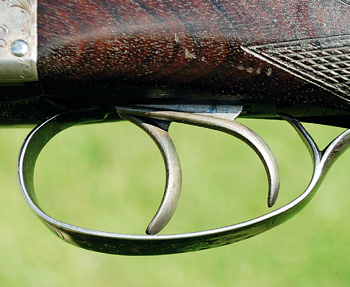Webley & Scott 700 shotgun review

Webley & Scott 700 shotgun review
Manufacturer: Webley & Scott
This month’s test gun is something really rather special – a 30″ barrelled Webley & Scott side-by-side with a semi-pistol grip stock and a flat file cut rib.
It was built, save for the double triggers, as a copy of Percy Stanbury’s famous gun and was specified by Stanbury himself when he was working as an instructor and gun fitter at the West London Shooting Ground in the 1950s.
Stanbury’s iconic boxlock, the one with all the silver ovals on the butt representing his many championship wins, now resides with Doug Florent at the Oxford Gun Company. But, I had never suspected that a near identical gun might have been made.
Its existence was, happily, brought to my attention by Alastair Phillips, the gun room manager at William Evans, who kindly and most efficiently brokered its purchase on my behalf.
First impressions are of a Standard 700 – it has the usual fairly open scroll engraving and colour case hardening on the fixed-pin boxlock action.
The more you look at and handle the gun, however, the more distinctive it appears to become. It feels weighty, and is quite muzzle heavy. It tips the scales at 7lbs 4oz., though you might think more – something around the 7.1/2 – 7.3/4lbs mark was my first guess.
The stock is well conceived with its long, open radiused and relatively thin, grip and a significantly tapered comb. It is quite long too, at 13.8″, with a Silvers red rubber pad fitted. There is 3/16″ extra length at heel and 1/2″ at toe.
Classic stuff
The rear of the butt sole is well-rounded. The wood itself is of good quality, though not elaborately figured. The chequering is nothing special but competent – typical 700.
The barrels are perhaps the most interesting part of the gun. They are 30″ long, heavy and fitted with a very distinctive flat and tapered file cut rib of pigeon type and very tight chokes.
The top surface of the rib is not machined but has been hand filed in time-honoured fashion. The gun bears the original 3.1/4 ton Birmingham marks for 2.3/4″ cartridges and is well in proof. The barrels have very thick walls.
Two dents have been expertly raised near the muzzles – and it is nice to see the work so well done.
The barrels are constructed on the dovetail system (like most Webley & Scott boxlocks). They are in generally excellent condition since their minor repair. The forcing cones are of traditional length and measure, about half an inch. Internally, the bores are absolutely true.
The fixed hinge pin design in the action is often seen as the 700s short-coming. It lent itself to economical manufacture, and is sometimes blamed for the 700s habit of coming ‘off the face’ prematurely.
The real culprit, however, was not the hinge pin but the design of the hook on the front lump. The lower part of this could bend open, although the hook on this 700 seems more substantial than on some 700 type guns. Should the problem occur, it is easily rectified, moreover, by the modern technique of TIG welding the hook to renew the bearing surface.
Absolutely marvellous
This is not the world’s most gaudily decorated gun, but it is one of the best shooting side-by-sides that I have ever encountered. This is an opinion shared by various shooting friends including Alastair Phillips, Will Garfit, and Jonathan Irby, manager of the West London Shooting Ground.
It is very different from the typical 700.
Thanks to its tight choking it has the quality of reaching out at range and dusting just about any bird. Recoil control is excellent. The flat file cut rib with small metal bead presents an excellent picture to the eye. The meaty barrels impart a very steady quality to the gun and the semi-pistol grip makes it easy to control the muzzles.
In its first competition outing at this year’s British side-by-side championship at the Broomhills ground it almost did the business but I lost it on the last stand. The following day the Stanbury style 700 took High Gun at an Essex clay shoot against 100 or so over-unders and semi-automatics.
By the time you read this it will have been tested on the moors as well!
Meantime, I can’t say more than I am absolutely delighted and offer my thanks to Alastair who worked very hard to get the gun for me.
I shall never sell it.
My success with the new gun prompts me to ask a question: ‘Is the side-by-side as good in absolute terms as the over-under’? The stack barrel has the oft-noted advantage of a single sighting plane and tends to control recoil more efficiently.
The side-by-side, especially in Anson and Deeley boxlock form, has simplicity on its side, and better gape for reloading. It tends to be harder to regulate – the barrels having a tendency to ‘shoot apart’, hence the flats at the muzzle often visible where the tubes meet, but that is no problem in a well-made gun.
Most people who are not used to side-by-sides certainly seem to find over-unders a little easier to use, hence their almost universal use at shooting schools.
They tend to control recoil better and there is no torque effect on firing, as created by chambers to right and left of the centre line. I am of the opinion, however, that any advantage to the over-under is primarily because it tends to be made heavier and with longer barrels.
Eliminate these variables, as is the case with the test gun, and there is precious little difference.








